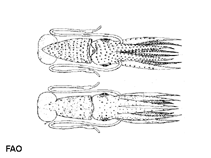Histioteuthis reversa (Verrill, 1880)
Elongate jewell squidWarning: DOMDocument::load(): SSL operation failed with code 1. OpenSSL Error messages: error:140770FC:SSL routines:SSL23_GET_SERVER_HELLO:unknown protocol in C:\Apache24\htdocs\includes\SpeciesSummary.lib.php on line 1236
Warning: DOMDocument::load(): Failed to enable crypto in C:\Apache24\htdocs\includes\SpeciesSummary.lib.php on line 1236
Warning: DOMDocument::load(https://sealifebase.nrm.se/webservice/AquaMaps/getAMap.php?genus=Histioteuthis&species=reversa): failed to open stream: operation failed in C:\Apache24\htdocs\includes\SpeciesSummary.lib.php on line 1236
Warning: DOMDocument::load(): I/O warning : failed to load external entity "https://sealifebase.nrm.se/webservice/AquaMaps/getAMap.php?genus=Histioteuthis&species=reversa" in C:\Apache24\htdocs\includes\SpeciesSummary.lib.php on line 1236
Classification / Names Common names | Synonyms | CoL | ITIS | WoRMS
| Oegopsida | Histioteuthidae
Environment: milieu / climate zone / depth range / distribution range экология
пелагический; пределы глубины 0 - 4332 m (Ref. 106098). Temperate; 53°N - 22°S, 82°W - 37°E (Ref. 106965)
распространение страны | регионы FAO | Ecosystems | места находок | интродукции
Atlantic, Gulf of Mexico, the Caribbean and the Mediterranean Sea.
Length at first maturity / Size / Вес / Возраст
Maturity: Lm ? range ? - ? cm Max length : 20.0 cm ML самец/пол неопределен; (Ref. 104052)
Mainly feeds on osteichthyes (myctophids), followed by crustaceans (natantian), and occasionally on cephalopods. Bases their diet on pelagic nictemeral migrators (Ref. 106992).
Life cycle and mating behavior половая зрелость | размножение | нерест | икра | Fecundity | личинки
Members of the class Cephalopoda are gonochoric. Male and female adults usually die shortly after spawning and brooding, respectively. Mating behavior: Males perform various displays to attract potential females for copulation. During copulation, male grasp the female and inserts the hectocotylus into the female's mantle cavity where fertilization usually occurs. Life cycle: Embryos hatch into planktonic stage and live for some time before they grow larger and take up a benthic existence as adults.
Основная ссылка
ссылки | координатор | соавторы
Collins, M.A., C. Yau, L. Allcock and M.H. Thurston. 2001. (Ref. 1985)
Статус Красного Списка МСОП (Ref. 130435)
Не вызывающий беспокойства (LC) ; Date assessed: 05 May 2010
Статус СИТЕС (Ref. 108899)
Not Evaluated
CMS (Ref. 116361)
Not Evaluated
Угроза для людей
Использование человеком
| FishSource |
инструменты
дополнительная информация
Возраст/Размеры
рост
Зависимость между длиной и массой тела
Зависимость между длинами
морфология
личинки
численность
рост
Зависимость между длиной и массой тела
Зависимость между длинами
морфология
личинки
численность
ресурсы в Интернет
BHL | BOLD Systems | CISTI | DiscoverLife | FAO(Publication : search) | Fishipedia | GenBank (Геном, Нуклеотид) | GloBI | Gomexsi | Google Books | Google Scholar | Google | PubMed | Tree of Life | Wikipedia (Вперёд, поиск) | Zoological Record
Estimates based on models
Preferred temperature
(Ref. 115969): 4.8 - 13.9, mean 13.2 (based on 271 cells).



